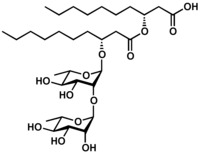
Photo from wikipedia
Abstract The impact of rhamnolipids (RL) biosurfactants presence on the phase-separation equilibrium, micellar properties and partitioning behavior of systems containing the aliphatic non-ionic surfactant Tergitol 15-S-7 (Tg7) was studied in… Click to show full abstract
Abstract The impact of rhamnolipids (RL) biosurfactants presence on the phase-separation equilibrium, micellar properties and partitioning behavior of systems containing the aliphatic non-ionic surfactant Tergitol 15-S-7 (Tg7) was studied in this work. The cloud points of Tg7 solutions (1‐ 10% w/w) in water and sodium citrate (NaCit) buffers pH 7.00 were increased after the RL addition (0.25% w/w) while they were decreased in NaCit pH 5.00. The most marked changes were verified for those systems with low Tg7 concentrations ( 7°). As expected, the zeta potential (ζ) of non-ionic Tg7 systems was close to zero; however, ζ became clearly negative (≅ −20 mV) in NaCit pH 7.00 after the addition of RL. This finding suggested that RL, which is negatively charged at pH 7.00, self-incorporated into Tg7 micelles and conferred them its charge. Hydrodynamic diameter (Dh) was either increased (in citrate media) or decreased (in water) by the RL, depending on the changes caused in the critical packing parameter of mixed micelles. Interestingly, an exponential decay equation, useful for predictive purpose, was found to correlate the cloud point with the hydrodynamic diameter, thus evidencing the crucial role of micelle size/shape on the phase separation. The partitioning behavior of cibacron blue (CB) and malaquite green (MG), negatively and positively charged dyes respectively, in Tg7 aqueous micellar two-phase systems (AMTPS) was significantly affected by the RL 0.25% w/w. In AMTPS with pH 7.00, the RL induced opposite effects, either duplicating the partition coefficient of MG or reducing it to a half for CB. Attractive and repulsive electrostatic interactions between the negatively charged mixed micelles and the partitioned molecules would be responsible of these trends. These results demonstrate the role of RL as a modulator of partitioning behavior of charged molecules and its potential use to improve recoveries and selectivity in a purification protocol.
Journal Title: Journal of Molecular Liquids
Year Published: 2020
Link to full text (if available)
Share on Social Media: Sign Up to like & get
recommendations!